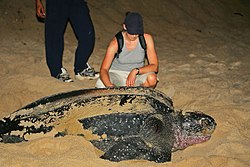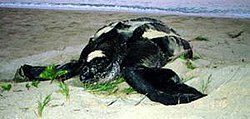Leatherback sea turtle
The leatherback sea turtle is the largest of all living sea turtles. It is the fourth largest modern reptile behind three crocodilians.[5][6]
| Leatherback sea turtle | |
|---|---|

| |
| Conservation status | |
| Scientific classification | |
| Kingdom: | Animalia |
| Phylum: | Chordata |
| Class: | Reptilia |
| Order: | Testudines |
| Family: | Dermochelyidae |
| Subfamily: | Dermochelyinae |
| Genus: | Dermochelys Blainville, 1816[3] |
| Species: | D. coriacea
|
| Binomial name | |
| Dermochelys coriacea | |

| |
| Synonyms[4] | |
|
List of synonyms
| |
Adults average 1–1.75 metres (3.3–5.7 ft) in shell length, 1.83–2.2 metres (6.0–7.2 ft) in total length and weigh 250 to 700 kilograms (550 to 1,540 lb).[7][8] The largest ever found was over 3 metres (9.8 ft) from head to tail and weighed 916 kilograms (2,019 lb).[9] It was found on a beach on the west coast of Wales.[10]
The eggs and young are often eaten by predators, but the adults can defend themselves aggressively. Only the largest sea predators can tackle a leatherback successfully.[11]
Leatherback turtles are one of the deepest diving marine animals. They have been recorded diving to depths as great as 1,280 metres (4,200 ft).[12]
They are also the fastest-moving reptiles. The 1992 edition of the Guinness Book of World Records lists the leatherback turtle moving at 35.28 kilometres per hour (21.92 mph) in the water.[13][14] Usually, they swim at 0.5–2.8 metres per second (1.1–6.3 mph).[15]
They can live as far north as Alaska and Norway and as far south as the Cape of Good Hope in Africa and the southernmost tip of New Zealand.[7] The leatherback is found in all tropical and subtropical oceans, and it also goes well into the Arctic Circle.[16]
Very little is known about how long they live. Some reports say "30 years or more",[17] while others say "50 years or more".[18]
Leatherback Sea Turtle Media
Leatherback sea turtle covering her eggs, Turtle Beach, Tobago
Leatherback turtle at Sandy Point National Wildlife Refuge
A leatherback turtle with eggs, photo taken on Salines de Montjoly beach (French Guiana)
References
- ↑ Wallace, B.P.; Tiwari, M. & Girondot, M. (2013). "Dermochelys coriacea". IUCN Red List of Threatened Species. IUCN. 2013: e.T6494A43526147. doi:10.2305/IUCN.UK.2013-2.RLTS.T6494A43526147.en.
- ↑ "Species Search".
- ↑ 3.0 3.1 Rhodin, A. G. J.; van Dijk, P. P.; Inverson, J. B.; Shaffer, H. B. (14 December 2010). Turtles of the world, 2010 update: Annotated checklist of taxonomy, synonymy, distribution and conservation status (PDF). Chelonian Research Monographs. Vol. 5. p. 000.xx. doi:10.3854/crm.5.000.checklist.v3.2010. ISBN 978-0965354097. Archived from the original (PDF) on 15 December 2010.
- ↑ Uwe, Fritz; Havaš, Peter (2007). "Checklist of Chelonians of the World" (PDF). Vertebrate Zoology. 57 (2): 174–176. Archived from the original (PDF) on 17 December 2010. Retrieved 29 May 2012.
- ↑ "WWF - Leatherback turtle". Marine Turtles. World Wide Fund for Nature (WWF). 16 February 2007. Retrieved 19 June 2012.
- ↑ "The Leatherback Turtle (Dermochelys coriacea)". turtles.org. 24 January 2004. Retrieved 19 June 2012.
- ↑ 7.0 7.1 "Species Fact Sheet: Leatherback Sea Turtle". Caribbean Conservation Corporation & Sea Turtle Survival League. Caribbean Conservation Corporation. 29 December 2005. Archived from the original on 28 April 2015. Retrieved 19 June 2012.
- ↑ Wood, Gerald (1983). The Guinness Book of Animal Facts and Feats. Guinness Superlatives. ISBN 978-0-85112-235-9.
- ↑ Eckert K.L. and Luginbuhl C. 1988. "Death of a giant". Marine Turtle Newsletter. 43: 2–3.
- ↑ Mystery of Wales turtle 'solved', BBC News, 2004, retrieved 19 June 2012
- ↑ "Sea Turtle". Seaworld. Archived from the original on 2013-05-29. Retrieved 2011-09-02.
- ↑ Doyle, T.K. et al 2008 (2008). "Leatherback Turtles satellite tagged in European waters". Endangered Species Research. 4: 23–31. doi:10.3354/esr00076.
- ↑ Shweky, Rachel (1999). "Speed of a Turtle or Tortoise". The Physics Factbook. Retrieved 19 June 2012.
- ↑ McFarlan, Donald (1991). Guinness Book of Records 1992. New York: Guinness.
- ↑ Swim speed and movement patterns of gravid leatherback sea turtles (Dermochelys coriacea) at St Croix, US Virgin Islands, Scott A. Eckert, The Journal of Experimental Biology 205, 3689-3697 (2002)
- ↑ Willgohs J.F. (1957). "Occurrence of the Leathery Turtle in the northern North Sea and off western Norway" (PDF). Nature. 179 (4551): 163–164. Bibcode:1957Natur.179..163W. doi:10.1038/179163a0. S2CID 4166581. Retrieved 19 June 2012.
- ↑ Dermochelys coriacea. "Dermochelys coriacea". Archived from the original on 12 July 2012. Retrieved 19 June 2012.
- ↑ Department of Energy and Environmental Protection. "Leatherback sea turtle". Archived from the original on 6 June 2024. Retrieved 19 June 2012.








